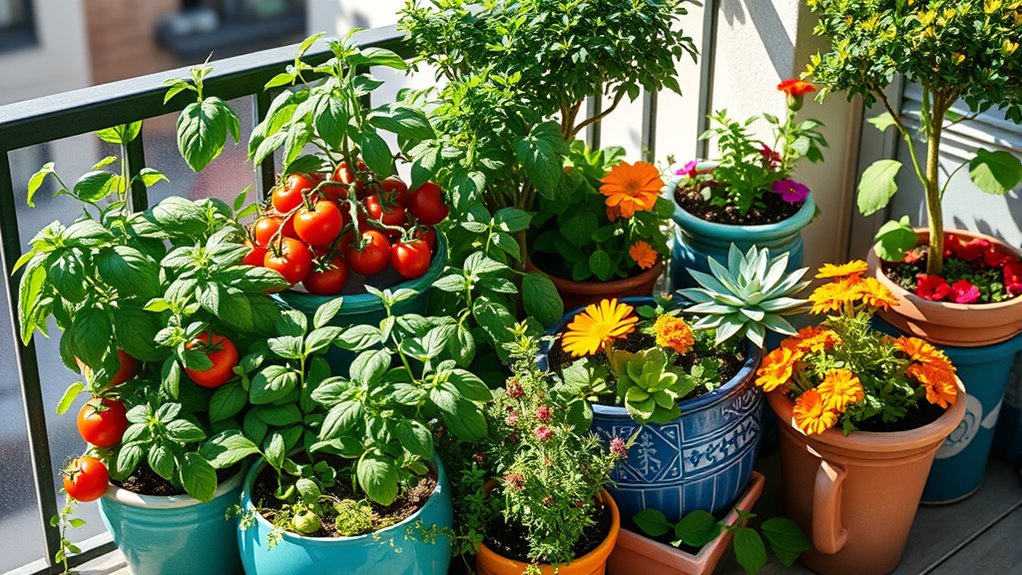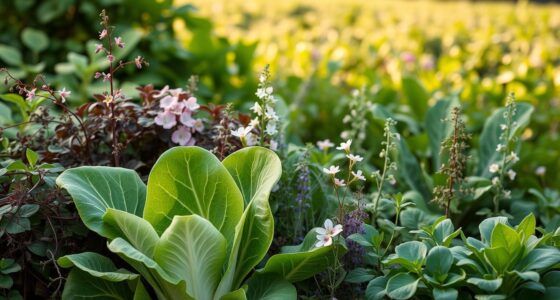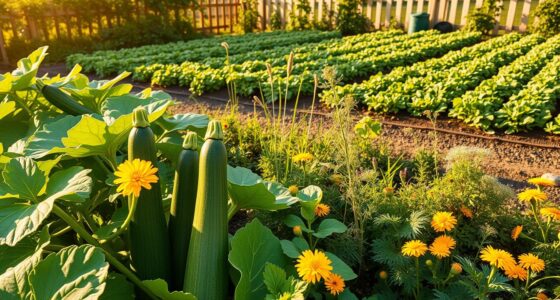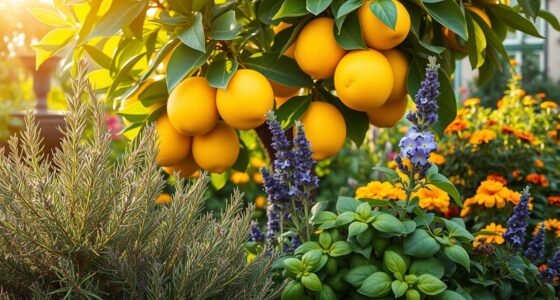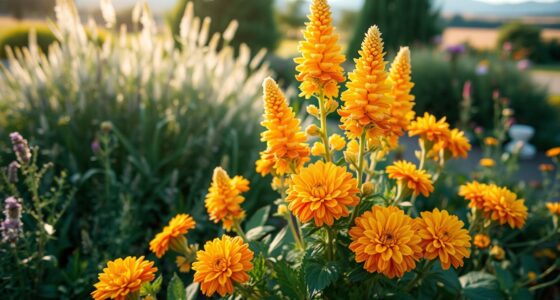Companion planting in containers and small spaces helps you maximize limited space, boost plant health, and naturally control pests. By pairing plants like basil with tomatoes or marigolds with peppers, you create a balanced ecosystem that enhances growth and repels harmful insects. Choosing the right containers, optimizing layout, and using smart plant combinations can turn your small garden into a thriving, attractive space. Keep exploring to discover how to make your container garden even more successful.
Key Takeaways
- Use strategic plant pairings like basil with tomatoes or marigolds with peppers to naturally repel pests in container gardens.
- Arrange taller plants at the back or center and shorter ones in front to optimize space and access.
- Incorporate nutrient-enriching plants like legumes to improve soil health within containers.
- Combine plants with similar water and light needs to simplify maintenance and promote healthy growth.
- Extend growing seasons and protect plants with covers, mini greenhouses, or frost blankets for year-round success.
Benefits of Companion Planting in Limited Spaces
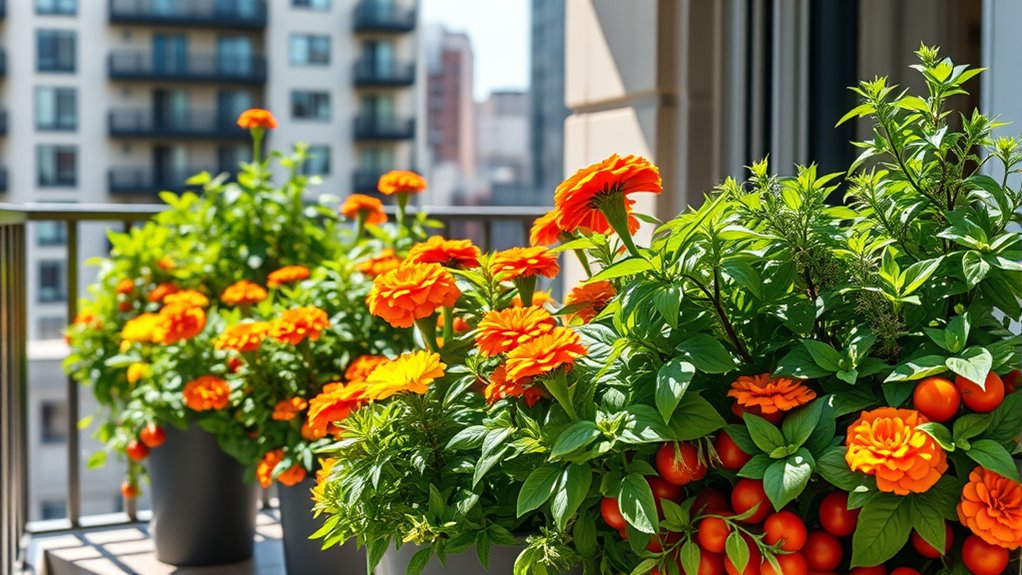
Even in small spaces or containers, companion planting offers significant benefits. It maximizes limited growing areas by allowing you to grow multiple plants close together. This practice naturally helps control pests and reduces the need for chemical interventions, as certain plants repel harmful insects. Companion planting also improves soil health; some plants fix nitrogen, enriching the soil for their neighbors. Additionally, pairing plants strategically can enhance growth and yield—fast-growing plants can provide shade or support for slower-growing ones. It also helps prevent diseases by promoting better airflow and reducing humidity around plants. Moreover, incorporating natural pest control methods further enhances the health of your garden ecosystem, making your garden more efficient, resilient, and productive, turning even tiny containers into thriving ecosystems.
Choosing the Right Containers for Your Garden
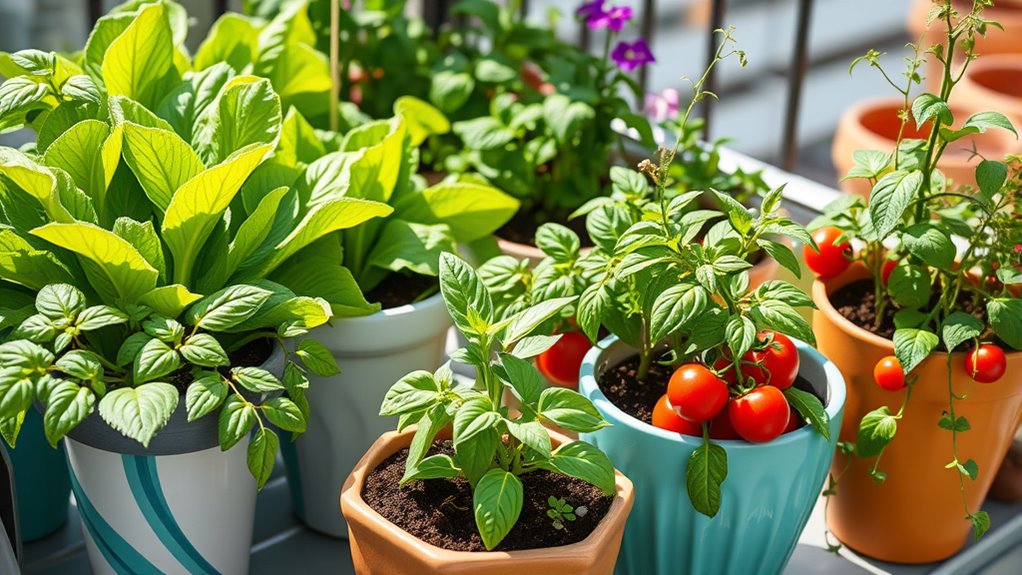
Choosing the right containers sets the foundation for a successful garden. You need to contemplate the material’s durability, the size for proper root space, and drainage to prevent overwatering. Additionally, pick styles that complement your space and aesthetic preferences to create a cohesive look. Considering the color accuracy you might need for vibrant plant displays can also enhance your setup and preparedness. Moreover, understanding how attention influences your creative process can help you select containers that promote focus and ease during planting and maintenance. Incorporating holistic approaches to health and wellness can also inspire you to choose eco-friendly and sustainable materials to support your overall garden environment. Being mindful of potential regulatory compliance issues related to materials and sourcing can help avoid future legal complications.
Material and Durability
Selecting the right containers for your garden depends heavily on the material’s durability and suitability for your environment. You want containers that can withstand weather changes without cracking, warping, or corroding. For outdoor gardens, materials like terracotta and ceramic look beautiful but may crack in freezing temperatures, so consider resin or plastic options if you face cold winters. Metal containers are sturdy but can heat up quickly, potentially damaging roots, so they might need insulation. Plastic is lightweight, affordable, and durable, but it may degrade over time when exposed to UV rays. UV resistance is an important factor to consider for plastics exposed to sunlight, ensuring longevity and sustained plant health. Additionally, understanding materials in AI in Education can help you make informed choices about technology use in your garden planning and maintenance. When selecting containers, also consider their ventilation features to promote healthy root growth and prevent overwatering issues.
Size and Drainage
The size of your containers directly influences plant growth and health. Larger containers provide more soil, which means better root development and consistent moisture. If your container’s too small, roots can become cramped, stunting growth and increasing stress. Choose a size that matches the mature size of your plants; too small, and they’ll struggle to thrive. Drainage is equally important—poor drainage leads to waterlogged soil, causing root rot and disease. Ensure your containers have drainage holes to allow excess water to escape. If they don’t, consider drilling holes or use a layer of gravel at the bottom to improve drainage. Proper sizing and drainage help maintain healthy roots, prevent overwatering, and promote vigorous, productive plants in your container garden. Additionally, selecting containers with appropriate soil quality can significantly impact overall plant health and growth. Proper soil amendments can further enhance drainage and nutrient retention for optimal plant development. Furthermore, choosing containers made from breathable materials like terracotta can also improve airflow around roots, reducing the risk of fungal issues and promoting healthier growth. Being mindful of the container material can also influence temperature regulation, helping roots stay cool during hot weather and preventing heat stress. Using insulating containers can further protect roots from extreme temperature fluctuations, ensuring a stable environment for your plants.
Aesthetic Appeal and Style
Since containers can greatly enhance the look of your garden, selecting ones that match your aesthetic vision is essential. Think about the style you want—modern, rustic, colorful, or minimalist—and choose containers that reflect that. Materials like ceramic, wood, metal, or plastic each bring a different vibe and can complement your plants and surroundings. Consider color, shape, and size to create harmony or contrast, depending on your preference. A cohesive look ties your garden together, while mixing styles can add visual interest. Don’t forget functionality; containers should be durable and suited for your climate. Additionally, understanding the importance of energetic alignment can help you cultivate a more harmonious and thriving garden environment. The right choice elevates your plant arrangement and transforms your small space into a garden that’s not only thriving but also beautifully styled. Incorporating unique and wicked planters can further personalize your garden’s aesthetic and reflect your individual style, which is a great way to practice home improvement by creating an inviting outdoor area.
Top Plant Pairings for Small Spaces

Choosing the right plant pairings can maximize your small space and boost your garden’s success. Complementary combinations help plants thrive together, while space-efficient strategies let you grow more in less room. Additionally, pairing pest-repelling plants with others can protect your garden naturally and effectively. Implementing container gardening techniques can further optimize limited space and improve plant health. Incorporating AI-powered gardening tools can assist in selecting the best plant combinations based on environmental factors and plant compatibility.
Complementary Plant Combinations
Pairing plants thoughtfully can maximize space and boost health in your containers and small gardens. When choosing complementary combinations, focus on plants that benefit each other naturally. For example, tomatoes thrive alongside basil, which can repel pests and improve flavor. Carrots grow well near onions or leeks, which help deter pests and enrich the soil. Lettuce pairs nicely with radishes, as radishes mature quickly and can be harvested before lettuce needs more space. Beans and marigolds also make a good match—marigolds repel nematodes, protecting beans. Consider plant height; taller plants like peppers or tomatoes can provide shade for low-growing herbs like thyme or parsley. These combinations optimize space, reduce pests, and promote healthier growth. Additionally, understanding how efficiency ratings influence heat pump performance can help you select the most suitable systems for your climate. Incorporating companion planting principles and knowledge of residency requirements can further enhance pest control and plant health, leading to more successful container gardening. To ensure optimal growth, pay attention to plant compatibility and avoid placing incompatible species together that may compete for resources. Recognizing plant compatibility can also help prevent disease spread and improve overall plant resilience.
Space-Efficient Pairings Strategies
Maximizing limited space requires strategic plant pairings that make the most of every inch. To optimize your small garden, choose pairings that serve multiple purposes. First, combine tall plants like tomatoes or beans with trailing herbs such as basil or thyme to utilize vertical space. Second, plant compact vegetables like lettuce or radishes alongside root crops like carrots to share container space efficiently. Third, mix fast-growing plants like spinach with slow-maturing ones like peppers, so they harvest at different times. Fourth, group plants with similar water and sunlight needs to simplify maintenance. These strategies help you maximize productivity without overcrowding, ensuring healthy growth and a lush, diverse mini-garden that thrives in small spaces.
Pest-Repelling Plant Duos
In small gardens where space is limited, incorporating pest-repelling plant duos can be a natural and effective way to protect your crops. Plant basil alongside tomatoes to deter aphids and whiteflies, keeping pests away from your fruit. Marigolds pair well with peppers and cucumbers, releasing compounds that repel nematodes and beetles. Nasturtiums act as trap plants, attracting aphids and whiteflies away from your vegetables. Lavender planted near beans or carrots can repel moths and fleas, reducing infestations. These duos not only ward off pests but also add beauty and diversity to your container garden. By choosing strategic pairings, you create a natural barrier that minimizes the need for chemical controls, helping your plants thrive in limited space.
Planning Your Container Garden Layout

Planning your container garden layout is a crucial step to guarantee healthy growth and efficient use of space. To start, consider the size of each plant’s mature spread, ensuring enough room for roots and airflow. Next, group plants with similar sunlight needs together to optimize growth conditions. Then, decide on a visual plan: place taller plants at the back or center and shorter ones in front for easy access and aesthetics. Finally, think about companion pairing: position plants that benefit each other nearby, like basil with tomatoes, to promote pest control and growth. Incorporating safety considerations, such as ensuring proper drainage and avoiding overcrowding, helps prevent issues and supports plant health. This organized approach helps prevent overcrowding, improves plant health, and creates a balanced, attractive space that maximizes your small area’s potential.
Soil Preparation and Nutrient Management

Before planting, preparing your soil is essential to guarantee healthy growth and nutrient availability. Start by choosing a high-quality potting mix suited for container gardening, ensuring it drains well but retains enough moisture. Mix in organic matter like compost or aged manure to boost fertility and improve soil structure. Test your soil’s pH; most plants prefer a slightly acidic to neutral range (6.0-7.0). Adjust as needed with lime or sulfur. Incorporate slow-release fertilizers or liquid feeds to supply essential nutrients throughout the growing season. Remember, healthy soil supports strong roots, vigorous growth, and better resistance to pests and diseases. Regularly replenish nutrients as plants grow, and avoid compacting the soil, which can restrict root development. Proper soil prep sets the foundation for a thriving container garden.
Watering and Maintenance Tips for Container Plants
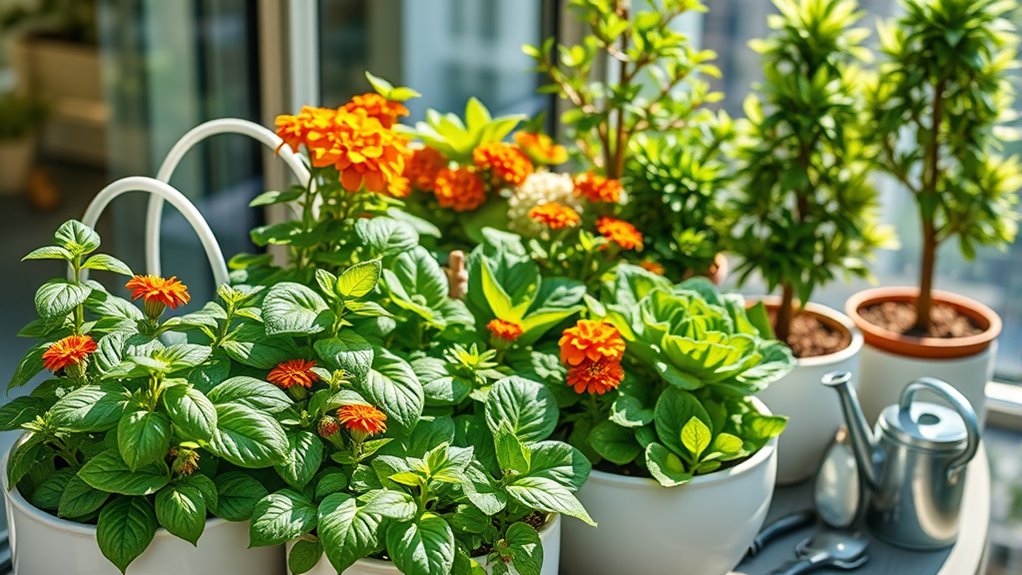
To keep your container plants thriving, you need to establish a consistent watering schedule that matches their needs. Make certain proper drainage to prevent waterlogging, and check your plants regularly for signs of pests or disease. Staying attentive to these maintenance tips will help your plants stay healthy and productive.
Consistent Watering Schedule
Maintaining a consistent watering schedule is essential for the health of your container plants. When you water on a regular basis, you prevent stress and ensure steady growth. To do this effectively, keep these points in mind:
- Check soil moisture daily, especially during hot weather, to avoid over- or underwatering.
- Water thoroughly until excess drains from the bottom, ensuring roots get enough moisture.
- Adjust your watering frequency based on plant type, container size, and weather conditions.
- Recognize signs of dehydration, like wilting or dry leaves, and respond immediately.
Proper Drainage Techniques
Proper drainage is essential for healthy container plants because it prevents water from pooling around the roots, which can lead to root rot and other diseases. To guarantee good drainage, use pots with drainage holes and add a layer of gravel or broken pottery at the bottom. Mix coarse, well-draining soil with organic matter to improve aeration. When watering, avoid over-saturating the soil; wait until the top feels slightly dry before watering again. Elevate containers on pot feet or bricks to allow air circulation underneath. Regularly check that excess water can escape freely and don’t let plants sit in standing water. Proper drainage promotes healthy root systems, encourages nutrient uptake, and keeps your container plants thriving.
Regular Maintenance Checks
Regular maintenance checks are essential to keep your container plants healthy and thriving. By staying attentive, you can prevent problems and promote growth. Here are four key tasks to focus on:
- Water consistently—check the soil daily, especially in hot weather, and water until excess drains out.
- Inspect for pests—look for discolored leaves, holes, or sticky residue, and take action immediately.
- Prune dead or yellowing leaves—this encourages new growth and improves airflow.
- Adjust fertilization—apply a balanced liquid fertilizer every few weeks to support ongoing health.
Performing these checks regularly guarantees your plants stay vigorous, vibrant, and well-maintained in your container garden.
Managing Pests Naturally With Companion Planting

Natural pest control through companion planting is an effective way to protect your container and small-space gardens without relying on chemicals. By choosing the right plant combinations, you can deter pests and reduce infestations. For example, planting marigolds near tomatoes helps repel nematodes and aphids, while basil can keep flies and mosquitoes at bay. Incorporate plants that attract beneficial insects like ladybugs and lacewings, which prey on common pests. Interplant herbs such as dill and cilantro to confuse pests and minimize their ability to locate target plants. Regularly monitor your garden, and use companion plants proactively to create a natural pest barrier. This approach not only safeguards your plants but also promotes a healthy, balanced ecosystem in your small-space garden.
Extending Your Growing Season in Small Spaces
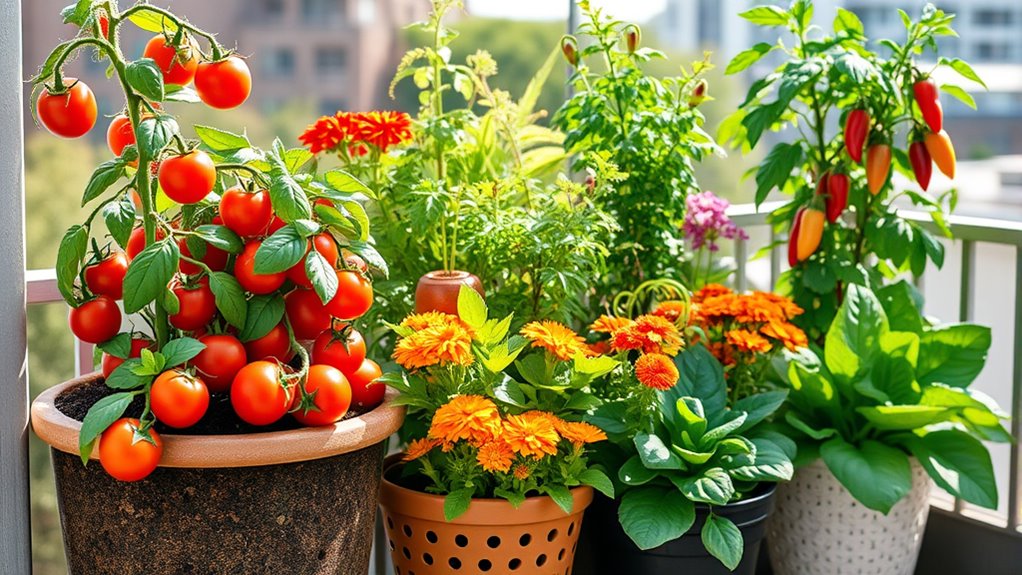
Even in small spaces, you can extend your growing season by using simple strategies that protect your plants from early frosts and harsh weather. First, consider using cloches or mini greenhouses over your containers to trap heat and shield plants from cold winds. Second, move potted plants indoors or to sheltered spots during cold snaps. Third, employ row covers or frost blankets to provide an extra layer of insulation overnight. Fourth, choose hardy plant varieties that tolerate cooler temperatures and shorter days. These tactics help you maximize your harvest and enjoy fresh produce longer. With a bit of planning and quick adjustments, you can effectively stretch your growing season in even the tiniest of spaces.
Creative Ideas for Display and Arrangement
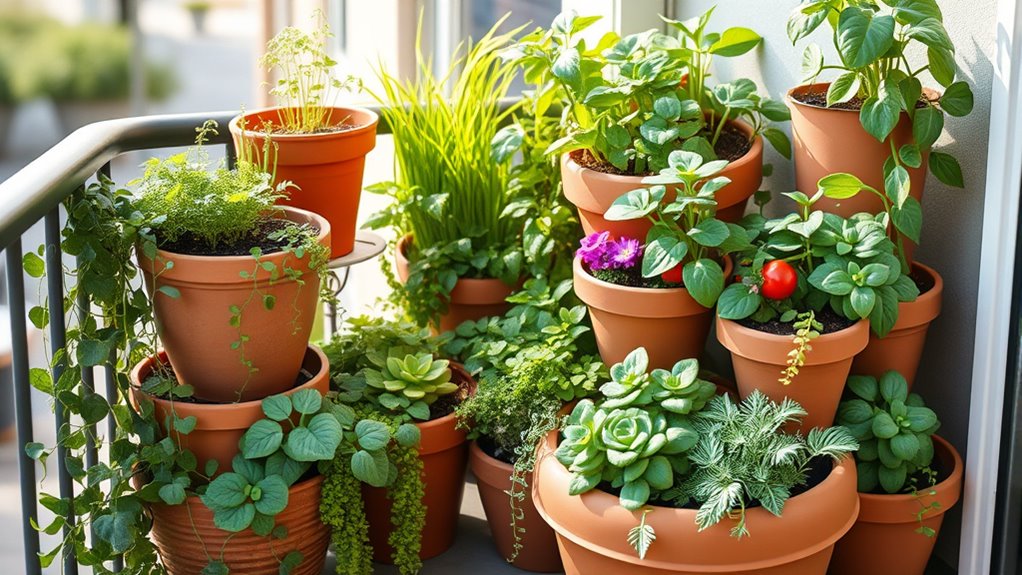
Transforming small spaces into eye-catching gardens starts with creative display and arrangement ideas that maximize visual impact. Use varying plant heights to create depth—place tall plants at the back or center and shorter ones in front. Incorporate colorful pots, hanging baskets, and tiered stands to add layers and interest. Mix different textures and foliage colors to keep the eye engaged. Group plants with similar care needs for a cohesive look, but vary their placement for contrast. Consider repurposing everyday objects like vintage crates or decorative trays as plant containers. Play with symmetry or asymmetry based on your style, and don’t forget to leave some open space to prevent clutter. These ideas will make your container garden both functional and visually stunning.
Troubleshooting Common Challenges in Container Gardens

While creative arrangements can make your container garden attractive, you may encounter common challenges that threaten its health and appearance. To troubleshoot effectively, identify issues early.
- Overwatering or underwatering: Check soil moisture regularly; adjust watering schedule accordingly.
- Poor drainage: Ensure containers have drainage holes and use well-draining soil to prevent root rot.
- Pests and diseases: Inspect plants weekly; remove affected leaves and use organic controls when needed.
- Nutrient deficiencies: Fertilize with balanced, slow-release or liquid plant food to promote healthy growth.
Addressing these issues promptly helps your plants thrive. Remember, consistent monitoring and adjusting care routines are key to overcoming common container garden challenges.
Frequently Asked Questions
How Do I Prevent Plant Conflicts in Small Containers?
To prevent plant conflicts in small containers, you should select plants with similar water, light, and nutrient needs. Make sure not to overcrowd, giving each plant enough space to grow. Regularly check for pests and diseases, and prune as needed to keep plants healthy. Using compatible plants together reduces competition, ensuring they thrive without overshadowing or harming each other. Proper planning and maintenance keep your container garden balanced.
Can Companion Planting Improve Pest Resistance Naturally?
You might think companion planting won’t make a difference in pest control, but it actually can. By pairing plants strategically, you create a natural barrier that confuses or repels pests, reducing the need for chemical interventions. Certain plants emit odors that deter unwanted insects, while others attract beneficial insects that prey on pests. So, yes, companion planting can enhance your garden’s pest resistance naturally, helping your plants stay healthier.
What Are the Best Plant Combinations for Shade or Sun?
When choosing plant combinations for shade or sun, you should consider each plant’s sunlight needs. For sunny spots, pair tomatoes with basil or peppers with marigolds—they thrive together and boost growth. In shaded areas, plant leafy greens like spinach alongside shade-tolerant herbs such as mint. These combinations guarantee your plants get the right light, promoting healthy growth and maximizing your garden’s productivity.
How Do I Manage Root Competition Among Container Plants?
Managing root competition is like tending a garden orchestra, where each instrument needs space to shine. You can prevent conflicts by choosing plants with different root depths, like pairing a shallow-rooted herb with a deep-rooted vegetable. Also, use taller plants as natural barriers to protect delicate roots. Regularly check soil moisture and avoid overcrowding; this keeps roots from fighting and helps all your plants thrive harmoniously.
Are There Specific Companion Plants for Herbs and Vegetables?
You want to know if certain plants work well together with herbs and vegetables. Yes, some companions boost growth and deter pests. For example, basil grows well with tomatoes, while marigolds repel nematodes and aphids. Carrots benefit from onions, and beans fix nitrogen in the soil. By pairing plants thoughtfully, you enhance your garden’s health and yield, making your space more productive and enjoyable.
Conclusion
By using companion planting in your small space, you can boost plant health, reduce pests, and maximize your harvest. Did you know that intercropping can increase yields by up to 25%? With the right container choices, smart planning, and natural pest control, you’ll turn even a tiny balcony or patio into a thriving garden. Keep experimenting and adapting—you’ll be surprised how much greenery and bounty you can achieve in limited space.
